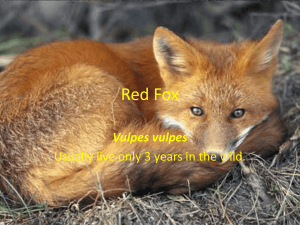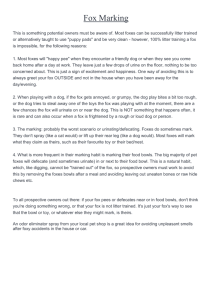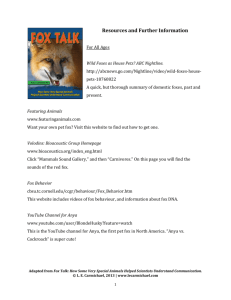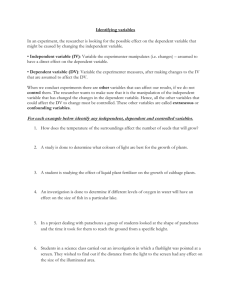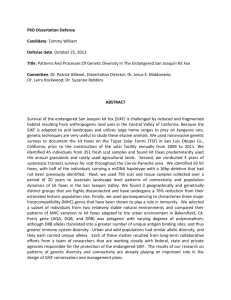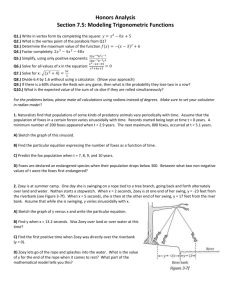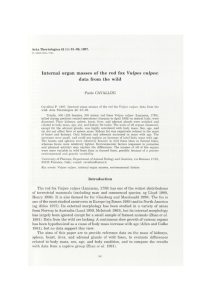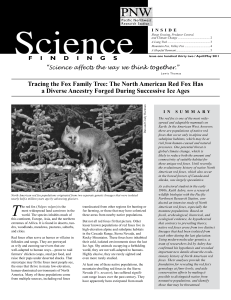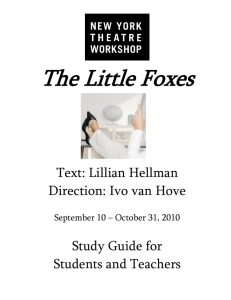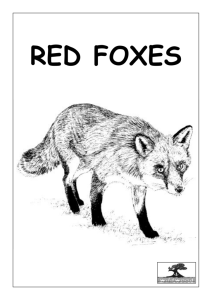Burwell Fox - Burwell House
advertisement
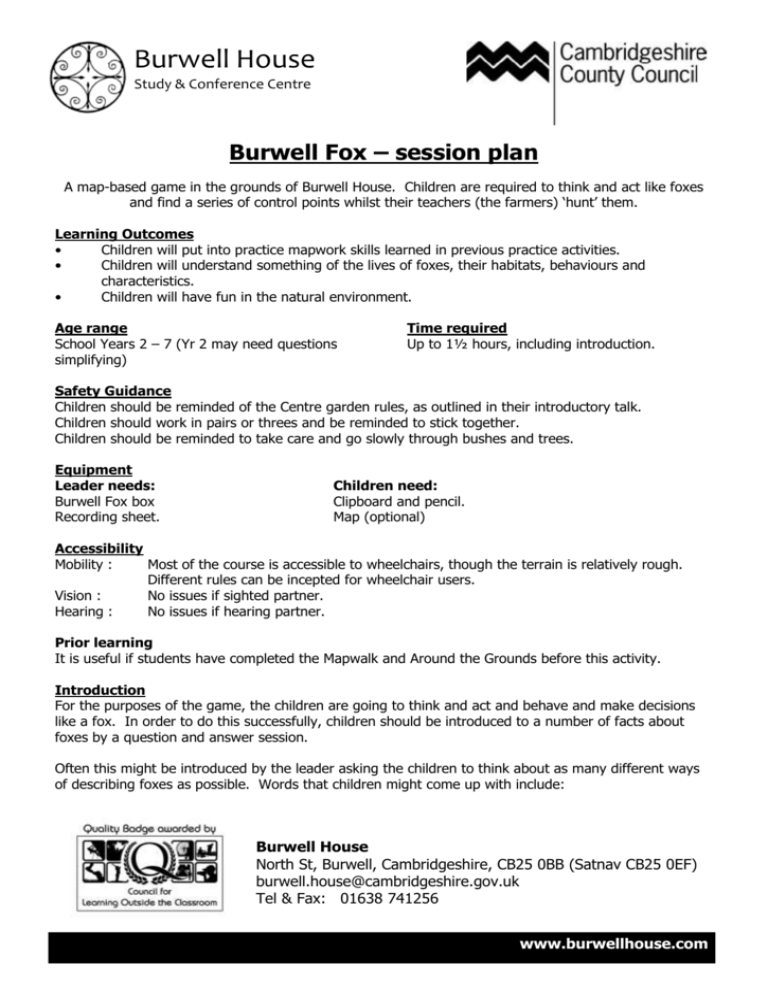
Burwell House Study & Conference Centre Burwell Fox – session plan A map-based game in the grounds of Burwell House. Children are required to think and act like foxes and find a series of control points whilst their teachers (the farmers) ‘hunt’ them. Learning Outcomes • Children will put into practice mapwork skills learned in previous practice activities. • Children will understand something of the lives of foxes, their habitats, behaviours and characteristics. • Children will have fun in the natural environment. Age range School Years 2 – 7 (Yr 2 may need questions simplifying) Time required Up to 1½ hours, including introduction. Safety Guidance Children should be reminded of the Centre garden rules, as outlined in their introductory talk. Children should work in pairs or threes and be reminded to stick together. Children should be reminded to take care and go slowly through bushes and trees. Equipment Leader needs: Burwell Fox box Recording sheet. Children need: Clipboard and pencil. Map (optional) Accessibility Mobility : Most of the course is accessible to wheelchairs, though the terrain is relatively rough. Different rules can be incepted for wheelchair users. Vision : No issues if sighted partner. Hearing : No issues if hearing partner. Prior learning It is useful if students have completed the Mapwalk and Around the Grounds before this activity. Introduction For the purposes of the game, the children are going to think and act and behave and make decisions like a fox. In order to do this successfully, children should be introduced to a number of facts about foxes by a question and answer session. Often this might be introduced by the leader asking the children to think about as many different ways of describing foxes as possible. Words that children might come up with include: Burwell House North St, Burwell, Cambridgeshire, CB25 0BB (Satnav CB25 0EF) burwell.house@cambridgeshire.gov.uk Tel & Fax: 01638 741256 www.burwellhouse.com Cunning Shy Clever Sly Shrewd Wily Stealthy Crafty Sneaky Quick Alert Fast Quiet Sleek The more information that can be got across about foxes, the better – the sort of things children need to think through and discuss might be: Habitat – Foxes naturally live in wooded areas but are very adaptable, so are able to live alongside humans, on farms, housing estates and in towns. Food – Foxes are omnivorous, eating small mammals, birds, minibeasts fruit etc. They are also scavengers, happily eating dead animals as well as human rubbish. Moving – Foxes are fast runners if necessary but can be quite slow if required. They are not good swimmers. Dangers – Foxes face a number of dangers in their lives, including: Fox hunting – hunting with dogs is, with a few exceptions, illegal, but many people argue that it is still occurring. In the UK more than 300,000 people belong to a hunt, where dogs and humans on horses were used to chase, and finally kill a fox. Poisons – many farmers and landowners lay poison for animals such as rats – this can be dangerous for a scavenger such as a fox. Traffic – a vast number of foxes are killed on the roads annually. Gamekeepers – traps and snares (there is an example of a trap in the Burwell fox box.) Farmers – poultry and sheep farmers in particular find the fox a pest and are likely to shoot them. Mapwork This game can be played with no map, or can utilise previously learned mapwork skills. If a map is being used, children should be reminded about their map skills. The Game Pairs or small groups of children must visit 12 controls around the garden. Controls are white and diamond shaped. Each is marked on the map. At each control, children must read and answer the Yes/No question it contains and note down the answer. To answer the questions children must think like a fox The movement of the children needs to be foxlike – hiding in bushes, creeping around, quietly and slyly. They will need to consider their routes between controls carefully. Whilst the children are searching for the controls teachers are out in the garden being farmers. The farmers are looking for non-foxlike behaviour. If pairs are spotted they will be shot by the farmer (stamped with a skull and crossbones on the reverse of their paper.) If there are spare adults, they can act as hunt saboteurs, lurking in the garden and helping the foxes as required. Once all 12 controls have been visited, or upon hearing the return signal, children should return to the base. At the base the ‘foxes’ can be introduced to part 2, in which children need to return to each of the controls and write down the highlighted letter in their third column. This is a method of getting more points, though they can still get caught! Plenary The scoring method is not rigid and can be adapted as necessary. Lives can be gained for each question pairs answer correctly and lost for each time pairs are stamped. In addition (if required) children can lose lives for wrong answers, and gain points if they get the code words (by rearranging the 12 letters they have found to make the words – BURWELL HOUSE). Once this is done, any groups with a positive score are alive foxes, and any with negative scores are dead foxes. www.burwellhouse.com This can lead to discussions about the survival of foxes in the real world, about the differences between animals facing dangers and endangered animals. Time can also be spent discussing success methods. If the children were to be asked to give advice to future participants, what would it be? National Curriculum Linked Objectives: Children should learn: • Geography: 2a. to use appropriate geographical vocabulary. • Geography: 2c. to use atlases and globes, and maps and plans at a range of scales. • Science 2: 5b. about the different plants and animals found in different habitats. • Science 2: 5c. how animals and plants in different habitats are suited to their environment. Answers Questions Answer, explanation, code letter No Fast traffic – too dangerous. R 2 You spot a dead bird lying on the motorway. Do you go and fetch it? A housing estate is being built near your home. Do you have to move? No U 3 You are having a drink and a deer approaches. Do you run away? No 4 You find dead rats by a bowl of grain. Do you eat them? Is this garden a good place for you to live? You hear dogs and horses. Do you run away? Here is a loop of wire across your path. Do you continue? Here is half a burger somebody has dropped on the pavement. Do you eat it? No Yes You are very adaptable and there are many urban foxes in Britain You have no natural predators, except in rare cases, badgers and golden eagles killing your cubs. A deer poses no threat. Rats are often poisoned. If you eat poisoned rats – you get poisoned too. Camouflage, food, soft earth, hiding places, water, shelter This might be a fox hunt. The hounds will sniff you out if you hide. Run! O No This might be a snare trap S Yes You are a scavenger. U No This might be a gin trap. W No You are not a great swimmer B Yes You are an omnivore H Yes Compost heaps are a great source of food for you and many other animals. Dig in! E 1 5 6 7 8 9 10 11 12 Here is some tasty raw meat in a woodland surrounded by leaves. Do you eat it? You see a big fish in a river. Do you dive in to catch it? You see some blackberries on a bush. Do you eat them? You find a compost heap. Do you dig into it to find some worms? Yes E L L www.burwellhouse.com
